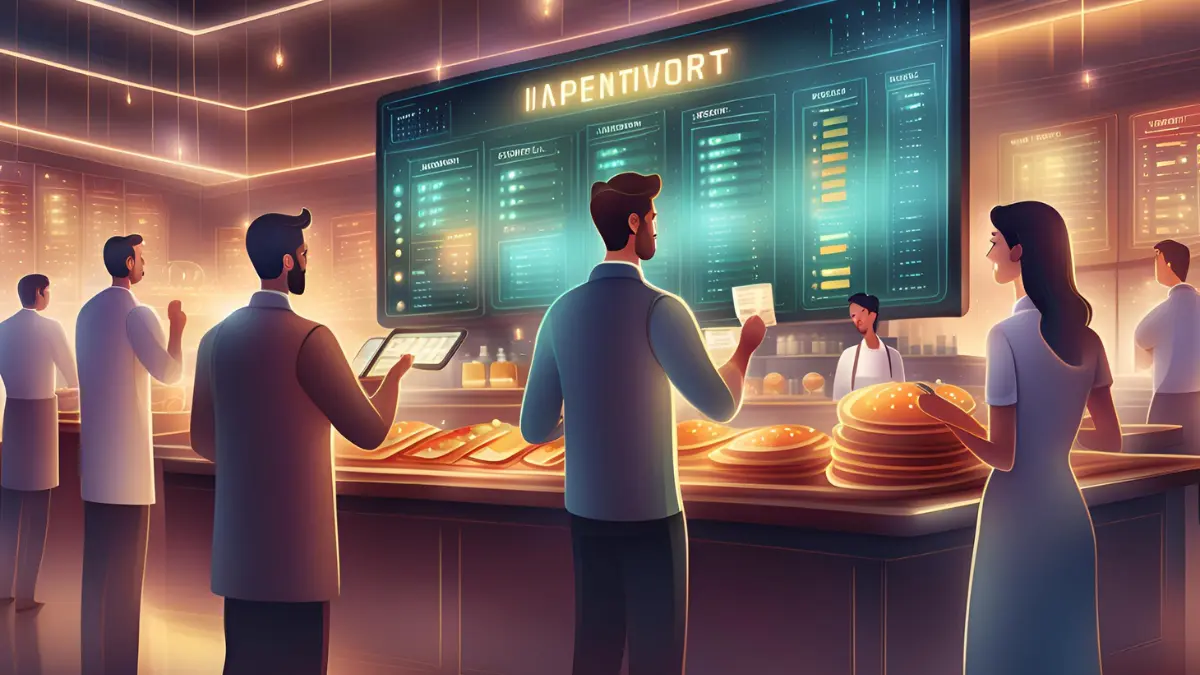Restaurant inventory management is the process of tracking and controlling stocks and supplies essential to restaurant operations. It ensures the right balance between inventory levels and demand, optimizing cost-efficiency and minimizing waste.
But how do restaurants overcome the everyday challenges of managing stock while ensuring smooth operations? From over-ordering to spoilage, businesses often struggle with inventory discrepancies, unpredictable demand, and tracking multiple supply sources.
Recent studies reveal the growing importance of advanced solutions. The Asia Pacific Inventory Management Software market, including Singapore, is projected to experience a compound annual growth rate (CAGR) of 11.9% from 2023 to 2030.
This data highlights the crucial role of a modern inventory management system in restaurant success. Therefore, this article will explore the 11 best practices in restaurant inventory management to help businesses streamline processes and improve efficiency.
Key Takeaways
|
Table of Content:
Table of Content
What is Restaurant Inventory Management and Its Benefits?
Restaurant inventory management is monitoring and controlling stock and supplies within a restaurant. It ensures the correct quantities are ordered, tracked, and used efficiently to meet demand, preventing shortages and excess stock.
According to a study on digital inventory optimization, optimizing stock levels reduces reserves and accelerates fund turnover. This helps businesses align inventory with consumer preferences, offering a competitive advantage through better service.
Understanding the benefits of inventory management can empower restaurant owners to implement more efficient systems. Below are the advantages of inventory management for restaurant businesses.
- Cost control: Prevents overstocking and reduces food waste, resulting in better cost management.
- Improved cash flow: Optimizes purchasing cycles, ensuring funds are not in excess inventory.
- Streamlined operations: Improves stock control, reducing manual errors and boosting operational efficiency.
- Accurate forecasting: Enables better prediction of demand based on historical data and trends.
- Enhanced supplier management: Understanding stock needs and consumption patterns helps negotiate better prices and terms.
- Better menu planning: Aligns inventory availability with menu offerings, ensuring seamless service delivery.
- Improved customer satisfaction: Ensures popular items are always in stock, preventing missed sales.
- Compliance and traceability: Facilitates adherence to food safety regulations by tracking stock origins and expiration.
Different Types of Restaurant Inventory
When managing restaurant operations, understanding the different types of inventory is essential for efficient stock control and minimizing waste. Here are the main types of restaurant inventory:
- Food ingredients: Perishable items like fruits, vegetables, meats, and dry goods.
- Beverages: Includes soft drinks, alcoholic beverages, and mixers.
- Non-food items: Cooking equipment, utensils, linens, and serving ware.
- Spices and garnishes: Flavoring components used in meal preparation.
Each type of inventory, from food ingredients to non-food items, plays a significant role in the smooth functioning of daily operations. Therefore, an efficient categorization ensures that stock levels are well-balanced.
11 Tips for Managing Restaurant Inventory Efficiently
Efficient restaurant inventory management ensures smooth operations and reduces unnecessary costs. Below are the 11 essential tips to help you manage your restaurant inventory efficiently, providing operational and financial success.
1. Track inventory regularly
Regularly tracking inventory ensures stock accuracy and prevents unexpected shortages or excesses. Weekly or bi-weekly counts help you stay informed of current stock levels and identify discrepancies early on. Implementing a cloud based inventory system can enhance tracking by providing real-time updates and minimizing manual errors.
2. Set par levels
Setting par levels for each inventory item ensures you always have enough stock without over-ordering. This minimizes excess stock and helps avoid running out of critical items during busy periods.
3. FIFO (First In, First Out) method
Inventory management for restaurant using the FIFO method ensures that older items are used first. This method reduces spoilage and waste, as perishable goods are rotated and consumed before expiration.
4. Forecast demand accurately
Using historical sales data to forecast demand helps align inventory with expected customer needs. Accurate forecasting reduces the risk of overstocking or running out of items, improving inventory turnover rates.
5. Train staff in inventory procedures
Training staff on proper restaurant and cafe inventory management procedures ensures consistency. Well-trained employees reduce inventory errors and contribute to smoother stock control processes.
6. Monitor supplier performance
Regularly evaluating suppliers ensures you work with reliable partners who meet your quality, cost, and delivery requirements. Monitoring supplier performance can help secure better terms and more consistent supply chains.
7. Maintain restaurant’s taste and quality
Food & beverage inventory management restaurant ensures the freshest ingredients are always in stock. Consistently using high-quality ingredients impacts your dishes’ taste and quality, helping you meet customer expectations and maintain the restaurant’s reputation.
8. Regularly update menu prices
Fluctuating costs of ingredients and supplies necessitate regular updates to menu pricing. Aligning prices with inventory costs helps maintain profit margins and ensures the sustainability of restaurant operations.
9. Analyze waste regularly
Tracking waste helps you identify patterns and adjust the process of your inventory management in restaurant industry accordingly. Regular analysis allows you to refine your ordering and preparation practices, reducing costs and minimizing waste.
10. Use a central kitchen
Using a central kitchen to prepare meals improves stock control and reduces ingredient waste. It also helps streamline operations, providing consistent food quality while making inventory management easier across multiple locations.
11. Leverage an Inventory Management System (IMS)
Implementing an IMS automates inventory tracking, reordering, and reporting in real time. This reduces manual tracking errors and ensures that stock levels are optimized. The system integrates seamlessly with POS systems for better management.
If you’re looking for a solution to streamline your restaurant’s processes, inventory management software offers a robust and scalable system. Click the banner below to explore the pricing schemes and find the perfect plan for your restaurant.
Restaurant Inventory Management KPIs
Tracking the right Key Performance Indicators (KPIs) is essential for effective restaurant inventory management. Below are the critical KPIs to monitor for streamlined inventory management in your restaurant.
- Inventory turnover ratio: This KPI measures how frequently inventory is sold and replaced within a given timeframe. A higher ratio indicates that stock is being used efficiently, while a lower ratio may signal overstocking or slow-moving items.
- Cost of Goods Sold (COGS): COGS tracks the total cost of ingredients used to produce the food sold. Monitoring this metric helps control costs and maintain profitability by ensuring that prices reflect the actual cost of production.
- Days Sales of Inventory (DSI): DSI calculates the average number of days it takes to sell inventory. A lower DSI means faster turnover, which is crucial for perishable goods to avoid spoilage and reduce holding costs.
- Stock variance: This KPI compares the actual stock on hand with the recorded stock levels. High variance can indicate theft, waste, or inaccurate inventory tracking and require immediate attention.
- Waste percentage: The waste percentage tracks the portion of inventory lost due to spoilage, over-preparation, or other inefficiencies. Keeping this number low helps reduce costs and ensures efficient resource use.
Important Restaurant Inventory Terminology
Understanding key restaurant inventory terms is essential for improving efficiency and making informed decisions. Here are the terms to enhance your restaurant inventory management and operational success:
- Par levels: The minimum stock required to meet demand without overstocking.
- Food cost percentage: The ratio of ingredient cost to revenue.
- Lead time: The time between placing an order and receiving stock from suppliers.
- Variance: The difference between recorded and actual inventory.
- Shrinkage: Loss of inventory due to theft, spoilage, or errors in management.
Restaurant Inventory Management Case Study
McDonald’s, one of the world’s largest fast-food chains known for its burgers, fries, and beverages, has revolutionized its operations with cutting-edge technology, including self-service kiosks and a robust restaurant inventory management system.
The self-service kiosks allow customers to place orders directly, improving speed and reducing errors. These orders are seamlessly integrated into the kitchen system, ensuring smooth preparation.
McDonald’s inventory system tracks stock levels in real time and automatically reorders supplies when quantities reach predefined levels. This system ensures that restaurants maintain optimal stock while reducing waste and preventing stockouts.
Additionally, McDonald’s leverages data analytics to forecast demand based on historical sales and customer behavior. This helps ensure that high-demand items are always available, improving customer satisfaction and avoiding sales loss due to stock shortages.
The system is designed for scalability, serving thousands of locations worldwide. This integration of kiosks, inventory tracking, and data analytics ensures consistent quality and fast service, making McDonald’s a leader in fast-food operational efficiency.
How to Choose an Inventory Management System for Your Restaurant
Choosing the right Inventory Management System (IMS) is crucial as it directly impacts efficiency and profitability. Below are several key factors to consider when selecting a restaurant inventory management app.
1. Identify your business needs
Evaluate your restaurant’s requirements, such as stock tracking and vendor monitoring. Selecting the right restaurant inventory management software ensures you address core challenges and streamline inventory processes effectively.
2. User-friendliness
A user-friendly inventory management software restaurant system ensures fast adoption by your team. It reduces training time, prevents errors, simplifies daily inventory tasks, and ensures everyone can easily manage stock levels.
3. Features and functionality
When selecting an IMS, assess its features, such as inventory tracking, forecasting, vendor management, and reporting. The inventory management system restaurant should offer the functionality that matches your restaurant’s unique operational needs.
4. Integration capabilities
Select an IMS that integrates with your POS and accounting systems. The best restaurant inventory management software will seamlessly merge operations, reducing data entry and ensuring smooth real-time synchronization between sales and inventory.
5. Customer support and training
Look for an IMS provider that offers robust customer support and training. This ensures your staff can quickly adapt to the restaurant inventory management system, minimizing downtime and enhancing efficiency through ongoing support and learning resources.
If you want to explore practical solutions for streamlining your restaurant’s operations, we have curated a list of the best inventory management software to help optimize your restaurant’s inventory management process.
Conclusion
Effective restaurant inventory management is essential for maintaining control over stock, reducing waste, and optimizing profits. By monitoring key metrics and using advanced tools, restaurants can streamline operations and improve decision-making processes.
HashMicro’s Inventory Management Software offers a scalable solution tailored to your restaurant’s needs. Real-time tracking, automated reordering, and seamless POS integration enhance efficiency and inventory control for businesses of all sizes.
Ready to take control of your restaurant inventory? Sign up for a free demo today and discover how HashMicro can boost operational efficiency.
FAQ About Restaurant Inventory Management
-
What is the best inventory method for restaurants?
The best restaurant inventory method is the FIFO (First In, First Out), which ensures that older stock is used before newer stock. This method minimizes spoilage and waste, particularly for perishable items, while helping maintain fresh inventory.
-
How often should a restaurant do inventory?
A restaurant should conduct inventory checks weekly, although more frequent counts may be necessary for high-volume establishments. Regular inventory assessments help identify discrepancies, manage stock levels effectively, and reduce waste.
-
How to categorize food inventory?
Food inventory can be categorized into several groups, such as perishable, non-perishable, and prepared items. This classification helps streamline stock management, making it easier to track usage, forecast needs, and reorder efficiently.


























































